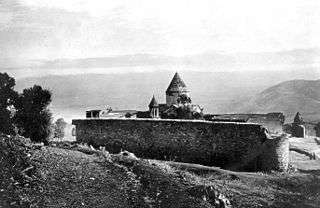Battle of Holy Apostles Monastery
| Battle of Holy Apostles Monastery | |||||||
|---|---|---|---|---|---|---|---|
 Early 20th century photograph of Holy Apostles Monastery, where the battle took place. | |||||||
| |||||||
| Belligerents | |||||||
| Armenian fedayi |
| ||||||
| Commanders and leaders | |||||||
|
Andranik Ozanian Kevork Chavush |
Ferikh pasha Ali pasha | ||||||
| Strength | |||||||
|
22 (Andranik, Kevork, Haroutiun from Ouroukh, Vagharshag, Hajji Hagop, Ghazar, Seydo Boghos, Andrig, Missak, Vartan, Assadour, Simon, Terpetos Sarkis, Cheto, Yegho, Parsegh, Hovsep son of Oso, Chatalbash Aram, Megro from Khaskiugh, Moso, Iso, Mourad from Havadorig)[1] 30[2]–38[3] | 6,000[4] | ||||||
| Casualties and losses | |||||||
| 3 (Ghazar, Haroutiun and Parsegh)[5] |
1,800 553 (according to Armenian eyewitnesses who were forced to supply food and clothing to the Turkish soldiers) 33 (Turkish sources)[6] | ||||||

The Battle of Holy Apostles Monastery (Armenian: Առաքելոց վանքի կռիվը Ařak'elots vank'i křivë) was an armed conflict between Ottoman Empire's forces and the Armenian militia in Holy Apostles Monastery near Mush, Ottoman Empire in November 1901. Andranik Ozanian's intentions were to attract the attention of the foreign consuls at Mush to the plight of the Armenian peasants and to provide a glimmer of hope for the oppressed Armenians of the eastern provinces.[7]
Background
The Social Democrat Hunchakian Party and Armenian Revolutionary Federation were two Armenian organizations of Armenian national movement active in the region. In 1894, Sultan Abdul Hamid II began to target the Armenian people in a precursor of the Hamidian massacres. This persecution strengthened nationalistic sentiment among Armenians.
In 1899 several Armenian fedayee commanders were killed, and Andranik Ozanian was charged with the leadership of all the partisan sources in Sasun district, in Bitlis Vilayet. His name became famous. Under Andranik's command were thirty-eight villages.[3]
The Battle
While the Turkish forces relentlessly pursued the fedayeen on the plain of Mush, on November 20, 1901 Andranik came down from the mountains with 30 fedayees (Kevork Chavush, Hakob Kotoyan and others) and 8-10 peasants from Tsronk village, hardened in constant skirmishes, and barricaded himself in the Holy Apostles Monastery in the southern suburbs of Mush.[2]
An entire regiment of five Turkish battalions, commanded by Ferikh and Ali pashas, besieged the well-fortified monastery. The Turkish generals leading the army of twelve hundred men asked the fedayees to negotiate their surrender.[8] During this period the Turkish army had great losses because of cold weather and epidemics. After the nineteen days' resistance and long negotiations, in which Armenian clergy as well as the headman of Mush and foreign consuls took part, Andranik and his companions succeeded in leaving the Arakelots monastery and fleeing in small groups. According to Leon Trotsky, Andranik dressed in the uniform of a Turkish officer, "he went the rounds of the entire quard, talking to them in excellent Turkish", and "at the same time showing the way out to his own men".[9]
Aftermath
After breaking out of the Arakelots Monastery, Andranik gained legendary stature among provincial Armenians.[10] "Andranik is not a human being, he is a ghost", Turks used to say after he disappeared. The Kurds believed that when at night Andranik took off his coat, many bullets fell from it.[11] Andranik commanded during the Second Sasun Resistance in 1904, then retreated with his men into Iran, resigned from the Dashnaktsutyun and thereafter traveled to Europe, where he participated in the First Balkan War.[12] Andranik published his memoirs, The Battle of Holy Apostles' Monastery, in 1924 in Boston.
It was necessary to show to the Turkish and Kurdish peoples, that an Armenian can undertake a gun, that an Armenian heart can fight and protect his rights.— Andranik, 1924
Bibliography
- The Battle of Holy Apostles' Monastery by Gen. Andranik, wr. Lewon K. Liwlēchean - London, 2008, ISBN 9781903656808, 59 pages
- General Andranik and the Armenian Revolutionary Movement, by Antranig Chalabian - Southfield, 1988, ISBN 9780962274114, 588 pages
References
- ↑ The Battle of Holy Apostles' Monastery by Gen. Andranik, wr. Lewon K. Liwlēchean - London, 2008, ISBN 9781903656808 - p.40
- 1 2 Military history: Vol. 12; 1995, Bold and fiercely determined, Andranik Ozanian spent most of his life as a revolutionary for his fellow Armenians, by Antranig Chalabian
- 1 2 The war correspondence of Leon Trotsky: The Balkan Wars 1912-13, 1980, p. 249
- ↑ The Battle of Holy Apostles' Monastery by Gen. Andranik, wr. Lewon K. Liwlēchean - London, 2008, ISBN 9781903656808 - p. 57
- ↑ The Battle of Holy Apostles' Monastery by Gen. Andranik, wr. Lewon K. Liwlēchean - London, 2008, ISBN 9781903656808
- ↑ The Battle of Holy Apostles' Monastery by Gen. Andranik, wr. Lewon K. Liwlēchean - London, 2008, ISBN 9781903656808 - p. 55
- ↑ Military history: Volume 12. Empire Press. 1995. pp. xviii.
- ↑ The Armenians: history of a genocide, by Yves Ternon - 1990, p. 114
- ↑ The war correspondence of Leon Trotsky: The Balkan Wars 1912-13, 1980, p. 250
- ↑ Encyclopedia of the Modern Middle East & North Africa: A-C, by Philip Mattar- p. 195
- ↑ The great 4: Mesrob, Komidas, Antranik, Toramanian, by Herminé D. Varjabedian, Shirak Press, 1969, p. 51
- ↑ Historical Dictionary of Armenia, by Rouben Paul Adalian, 2010, p. 79